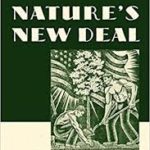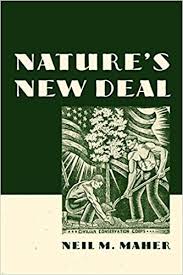The New Deal Against the Environmentalists

A Review of Neil Maher’s Nature’s New Deal (Oxford University Press, 2008)

The Civilian Conservation Corps (CCC) was one of the most popular and successful of the New Deal programs. Between 1933 and 1942, it put more than 3 million men to work, planted 3 billion trees, protected 20 million acres from soil erosion, helped establish 800 state parks, and installed 5000 miles of water lines. These are just a handful of the many infrastructural improvements accomplished by the Corps. In addition, it was an extremely popular program: in 1936, its approval rating stood at 82% (not coincidentally, Roosevelt won re-election that year with the second largest popular vote in U.S. history). Three years later, it rose to 84%.
As Neil Maher argues in Nature’s New Deal, the CCC was also philosophically opposed to and ultimately undermined by the forces that would coalesce into post-war environmentalism. For proponents of the Green New Deal, this fact should be a curious one: not only was the “greenest” of the original New Deal programs not established by nascent environmentalists, it was also internally fractured by their influence.
A Tale of Two Dams
In 1913, Congress decided to dam the Hetch Hetchy Valley in Yosemite National Park to provide water for San Francisco. Cheering the decision was Gifford Pinchot, first chief of the United States Forest Service and mouthpiece of the conservation movement. For Pinchot, conservation meant “the development and use of the earth and all its resources for the enduring good of men” (25). The underlying assumption of Progressive-era conservation was that nature is there for us: the reason it is imperative that we maintain natural resources such as timber, soil, and water is simply that human beings need these things to flourish. Damming the Hetch Hetchy made perfect sense to Pinchot. Cities need water, and the valley was there to hold it.
In fierce opposition to the dam were John Muir and the Sierra Club, who “believed in preserving nature’s beauty for its own sake as well as for the spiritual sake of humankind” (26). According to Muir and the preservationists, human beings were interlopers amongst “terrestrial manifestations of God,” stains on the ideal order of nature (26). Hetch Hetchy was a temple, its damming a sacrilege. Less than a year after the decision to build the dam, so the story goes, Muir “died of a broken heart.”
The preservationists might have lost the battle, but they would eventually win the war. In the late 1940s, a plan was hatched to build a similar dam in the Echo Park section of Dinosaur National Monument. The same foes faced off once again, but this time their fortunes were reversed: after much protest, the project was abandoned in 1955, a moment that, “many argue, unleashed modern environmentalism in the United States” (220).
For Maher, it is impossible to understand this tale of two dams without looking to the fates of the competing visions that animated and undermined the CCC. At its inception, the Corps was the fruit of Pinchot’s utilitarian conservationism, its early work of combatting “timber famine” and soil erosion carried out in the name of greater economic productivity. Around 1935, another strand of Progressive ideology, represented in the writing of Frederick Law Olmsted, began to shape the CCC’s work: that of “the belief in the rejuvenative power of the countryside” to cure the nervous ills of “overcivilized man, who [had] lost the great fighting, masterful virtues” (32-33). To promote outdoor recreation, the CCC increasingly turned to national and state park development, and their work paid dividends. In 1933, less than 3.5 million people visited national parks; by 1941 that number jumped to 21 million (73). The purview of Pinchot’s “simple conservation” was thus expanded to include not just trees, soil, and water, but parks as well.
Olmsted’s thinking was a natural fit for a project that understood itself more broadly as about the rejuvenation of men in the wake of the Depression. According to the Corps’ second director, James McEntee, CCC enrollees came “almost entirely from that third of the population which President Roosevelt has described as ‘ill fed, ill housed, and ill clothed’” (83). The Corps aimed not only to alleviate this impoverishment but also to harden the bodies and minds of the young men it employed. Indeed, the CCC’s first director, Robert Fechner, understood “the central role played by this labor” to be the source of the program’s success: “I believe that the general popularity of the Corps is due in large measure to the belief of the general public that it has not been conducted as a welfare organization but has engaged in useful worthwhile work” (84).
It’s worth noting that neither Fechner nor McEntee came from the conservation movement. The CCC was originally opposed by organized labor and the Socialist and Communist parties, and the appointments of Fechner and McEntee, two machinists’ union organizers, to direct the Corps were necessary for FDR to overcome this initial hostility. Such was the birth of the CCC: two machinists re-virilizing the nation’s young men to make efficient use of America’s natural resources.
Paved Paradise, Put Up a Parking Lot
In 1934 Aldo Leopold, an early CCC booster who had grown critical of its projects, gave a speech to the University of Wisconsin’s Taylor-Hibbard Economics Club. In it he described Corps crews as brash and destructive, chopping down eagles’ nests in the name of “timber stand improvement,” ruining the natural habitats of many species of migratory waterfowl, and generally as suffering from a lack of “ecological” understanding (165-166).
At that point the term “ecology” was unfamiliar to most Americans. Leopold meant by it a kind of systems-level thinking interested in “harmonious balance” that transcended the blinkered views of CCC farming, forestry, game cropping, and soil erosion experts (167). His “ecological critique of the CCC and its conservation work… migrated from the Midwest eastward and took root in the academic halls of Cambridge, Massachusetts,” where it unsurprisingly took on an even more paternalistic tone (167). Harvard botany professor Merritt Fernald dismissed CCC enrollees as “misguided and enthusiastic young men” (168), and the national media soon jumped at the chance to chastise a working-class institution for being “ecologically irresponsible” (168).
This academic critique added fuel to the preservationist fire, and soon the Corps was being attacked on many sides for “destroying the ‘primitive’ quality of America’s public lands” (176). To rehabilitate the CCC’s image in the face of these attacks, in the late 30s Roosevelt attempted to bring all conservation work under a centralized authority that would embody the spirit of “true conservation,” i.e. the enlightened “ecological” thinking of academics and preservationists. Pinchot allied with labor to defeat the proposed reorganization plan in 1938, which many historians have argued “marked a turning point for Franklin Roosevelt’s presidency and an early step in a half-century-long rollback of New Deal liberalism” (183).
In one sense this was a victory for Pinchot’s “simple conservation,” but the vehicle for its enactment emerged badly bruised. In addition, the ecologists and preservationists were not to be deterred: in 1940 a new conservation organization called Friends of the Land was created to carry forth their interests. It was to be the first of many special interest groups to take up the torch of “total conservation,” and these are the precise groups that would eventually tip the balance in favor of the preservationists at Echo Park in 1955.
In Maher’s telling, modern environmentalism is thus something like a parasite, infecting and destroying the body of its Corps host in order to spawn NGO babies. Perhaps critics are right that many other “historical forces beyond Roosevelt and the federal government” are responsible for the genesis of post-war environmentalism, but from this reviewer’s perspective, Maher’s book is less about environmentalism itself than about its hand in the undermining of the CCC.
An Ecological Politics for the Working Class?
Proponents of the Green New Deal are quick to tell you that “jobs vs. the environment” is a false dichotomy, an invention of the Right perhaps, but Fechner and McEntee might not have been so quick to agree. The preservationists and ecologically-minded academics of the New Deal era not only had no hand in the genesis of the largest green jobs program in American history, but they also did a good deal to undercut it. The CCC was a success not because but in spite of the nascent environmental movement.
Though Maher does not delve too deeply into this aspect of his story, it is difficult to read Nature’s New Deal and not be struck by the class character of its inner tension. The young men employed by the Corps were poor and working-class, and their knowledge and skills were acquired practically in the course of transforming America’s landscape. The Corps’ critics were academics and wilderness enthusiasts, who framed their complaints in terms of science and morals. It’s true that Pinchot was, much like FDR, an aristocrat, and thus that “simple conservation” had Progressive technocratic rather than working-class roots, but the CCC itself was a working-class program and the paternalistic criticisms of it reflect that fact.
There is of course no need to unduly romanticize the CCC: enrollee salaries weren’t great, though they were often lifelines to their families. It was organized as a paramilitary unit, and to the end of inculcating the “great fighting, masterful virtues.” And it suffered from discriminatory and segregating hiring practices, even if it also opened new vistas for black enrollees, who comprised approximately 8% of the Corps.
But for all its shortcomings, there are many important lessons to be taken from the CCC experience, perhaps none more important than that regarding the strategy needed to achieve such a popular and transformative public works project. Green New Deal programs will be won by catering to and empowering organized labor to lead the efforts of green infrastructural projects, and they will be won in the name not of treading lightly on the earth or respecting divine nature, but rather of developing and using our natural resources for the enduring good of human beings.
In the tradition of Pinchot’s conservationism, Christian Parenti has argued against the “implicit Malthusianism” of modern environmentalism, which “casts humans as intruders upon a harmonious and static thing called ‘nature.’” For Parenti, “we cannot retreat from our role as environment makers,” an imperative that would have well-suited the architects of the CCC.
Looking at the history of America’s greatest green jobs program, it is clear that the environment-making nature of human beings is not simply a philosophical question. The lamentations of environmentalists past and present about the intrusions of human beings on pristine nature are often thinly-veiled reservations about the ability of working people to shape and benefit from the earth. If we’re to take history as our guide, we will win large-scale green infrastructural projects not with but against the tireless moralizing of environmentalists.